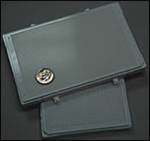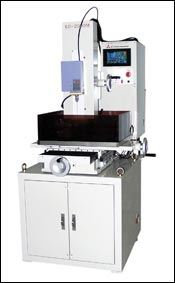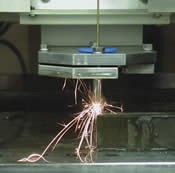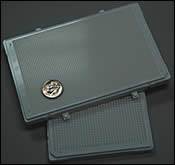A Hole Is Not Just a Hole
Increasing precision in small-hole EDM drilling.
When it comes to EDM drilling of hardened metals, such as mold and tool steels, there are holes, and then there are holes that actually do the job.
The difference lies in the precision of those holes top to bottom. A universal conundrum with most EDM drilling systems, however, is the tapering at the bottom of the hole—the condition affectionately known as bullet-nosing.
The Power behind the Tools
To combat the bullet-nosing effect, mold manufacturers need to consider several factors when purchasing their next high-speed, small-hole EDM drilling machine tool. They need to look not to the electrode itself, but rather to the power source driving the vaporization of the metal.
A power supply that uses conspicuously low unload voltage—less than 35 V—to burn materials going across EDM drills is one such feature to consider. This low voltage achieves high speeds with low wear on its electrodes.
Another feature is using regular tap water, plus an additive, in its operation as opposed to de-ionized water in other units.
All of these features will enable the machine to manufacture almost 15 full .040" holes in 2-inch-thick hardened D2 material with one electrode.
Using the lower voltage is a draw to many people in the metalworking field who have taken to other cutting technologies to avoid the very same problems that the right power supply can combat.
The right system can keep the end of the electrodes very square, and as a result, keep the bottoms of holes clean when the electrode breaks through.
Most EDM drills run at about 100 volts. You get a lot of electrode wear—like in excess of 300 percent—and you get a lot of bullet-nosing at the end of the electrode.
With the low voltage power supply you can burn much cleaner, straighter holes with less side gap, which keeps the end of the electrode really sharp. Electrode wear will be down, in some cases, as low as 20 to 25 percent.
Test Case
For example, in one test, holes were drilled through 17-4 stainless steel. The holes were 0.027 inches diameter and 0.035 inches deep. The EDM drill with a low voltage power supply burned the holes in eight seconds with only 25 percent wear on the electrodes. This allowed the 16-inch-long electrode to burn 150 holes. In addition, the recast (white) layer on the wall of the holes was 12 to 15 microns in thickness—below the 20-micron maximum allowed for the job. With a lower-voltage system you can minimize the side gap quite a bit.
Sinker Comparison
A shop could achieve comparable, and even better, results with a CNC sinker EDM; however, the sinker machine is going to cost more and require more time to finish the part run. For example, a manual EDM drill may cost around $25,000, compared to a starting price of about $95,000 for a CNC sinker EDM. While sinker EDMs are the right tool for many applications, if tolerance requirements don’t call for one, an EDM drill is probably the more reasonable option. You would get a much more accurate hole with the sinker, but it’s going to take considerably more time, and it’s also considerably more expensive.
Job Requirements
Shops doing small-hole EDM jobs should take a hard look at the specific requirements of the jobs they are quoting and let those dictate the technology they apply. If the job specifies hole diameters in the range of 0.012 to 0.120 inch, EDM drills can fit the bill. Anything finer—perhaps for a micro-mold—and a shop is probably looking at a sinker EDM unit with a fine-hole attachment.
Most small holes simply require only an EDM drill and run-through on a wire EDM to finish it.
What do you call a small hole? Is it a fine hole, a micro-hole? If you’re doing a production job—blade cooling holes or injection nozzle holes or other parts in a fuel injection system where the hole sizes are somewhere in the neighborhood of 25 thousandths—the EDM drill is a perfect application.
Step Back from the Laser
That has not been the prevailing wisdom among some metalworking shops in recent years.
In recent years, as the popularity of laser machines has increased, so have the number of customers using them for applications once reserved for EDM machines. However, as problems of blow-through and lack of uniformity throughout the entirety of holes have surfaced, some users are returning to EDMs as the preferred method of machining for certain applications.
In piece-part production, whether it be in cooling holes in jet turbine blades or injector nozzle holes, some manufacturers are moving away from laser and coming back to EDM small-hole drilling because it gives them much better hole consistency. With lasers, you get a lot of heat buildup and a lot of blow-through out of the bottom or the back side of the actual piece-part, and you don’t get a really nice, true, round hole with nice straight sides.
In addition, an EDM drill enables users to manufacture blind holes to a specific depth within about +/-0.005 inch. With other technologies, in order to do a blind hole to a specific depth, and hold the diameter all the way to the bottom of the hole, is impossible.
With the right EDM drill you can set it to burn to a specific depth, and the bottom of the hole is the right size, except maybe the last few thousandths at the very bottom where you run into a small wear radius. It’s very reasonable.
Summary
Taking the most common demands of customers—speed, accuracy, tool longevity and cost—into account, a low-voltage EDM drill for small-hole applications can fit a wide range of requirements. Now the task is to automate as much of the process as possible.
Related Content
Moldmakers Deserve a Total Production Solution
Stability, spindle speed and software are essential consideration for your moldmaking machine tool.
Read MoreTreatment and Disposal of Used Metalworking Fluids
With greater emphasis on fluid longevity and fluid recycling, it is important to remember that water-based metalworking fluids are “consumable” and have a finite life.
Read MoreConsiderations for Mold Base Material Selection
Choosing the right material can greatly affect the profitability and cost of your application.
Read MorePlastic Prototypes Using Silicone Rubber Molds
How-to, step-by-step instructions that take you from making the master pattern to making the mold and casting the plastic parts.
Read MoreRead Next
Machining/EDM Combo Packs a Powerful Punch
This moldmaker’s new machining center and EDM offer versatility with the ability to machine a number of materials and EDM small holes with ease.
Read MoreMachining/EDM Combo Packs a Powerful Punch
This moldmaker’s new machining center and EDM offer versatility with the ability to machine a number of materials and EDM small holes with ease.
Read MoreReasons to Use Fiber Lasers for Mold Cleaning
Fiber lasers offer a simplicity, speed, control and portability, minimizing mold cleaning risks.
Read More.jpg;maxWidth=970;quality=90)













_300x250 3.png;maxWidth=300;quality=90)





.jpg;maxWidth=300;quality=90)






